Three-Dimensional Physical and Numerical Modelling of Fracturing and Deformation Behaviour of Mining-Induced Rock Slopes
Abstract
:1. Introduction
2. Geological Settings
3. Physical Model Tests
3.1. Model Contaniner
3.2. Modelling of Rock Mass
3.3. Modelling of Rock Joints
3.4. Modelling of Mining Processes
4. Discrete Element Modelling
5. Physical Test Results
6. Discussion
6.1. Comparative Analysis of Physical Modelling Result and Numerical Simulation Result
6.2. Analysis of the Typical Strata Movement Characteristics
7. Conclusions
Author Contributions
Funding
Conflicts of Interest
References
- Fu, H.; Wang, S.; Pei, X.; Chen, W. Indices to Determine the Reliability of Rocks under Fatigue Load Based on Strain Energy Method. Appl. Sci. 2019, 9, 360. [Google Scholar] [CrossRef]
- He, L.; Zhang, Q.B. Numerical investigation of arcing mechanism to underground mining in jointed rock mass. Tunn. Undergr. Space Technol. 2005, 50, 54–67. [Google Scholar] [CrossRef]
- Wang, Y.; Jing, H.; Zhang, Q.; Luo, N.; Yin, X. Prediction of Collapse Scope of Deep-Buried Tunnels Using Pressure Arch Theory. Math. Probl. Eng. 2016, 3–4, 1–10. [Google Scholar] [CrossRef]
- Cheng, G.; Chen, C.; Ma, T.; Liu, H.; Tang, C. A Case Study on the Strata Movement Mechanism and Surface Deformation Regulation in Underground Iron Mine. Rock Mech. Rock Eng. 2016, 50, 1011–1032. [Google Scholar] [CrossRef]
- Bai, Q.; Tu, S.; Wang, F.; Zhang, C. Field and numerical investigations of gate road system failure induced by hard roofs in a longwall top coal caving face. Int. J. Coal Geol. 2017, 173, 176–199. [Google Scholar] [CrossRef]
- Li, Z.; Dou, L.; Cai, W.; Wang, G.; Ding, Y.; Kong, Y. Mechanical Analysis of Static Stress with in Fault-Pillars Based on a Voussoir Beam Structure. Rock Mech. Rock. Eng. 2015, 49, 1097–1105. [Google Scholar] [CrossRef]
- Ju, J.; Xu, J. Structural characteristics of key strata and strata behaviour of a fully mechanized longwall face with 7.0 m height chocks. Int. J. Rock Mech. Min. 2013, 58, 46–54. [Google Scholar] [CrossRef]
- Unver, B.; Yasitli, N. Modelling of strata movement with a special reference to caving mechanism in thick seam coal mining. Int. J. Coal Geol. 2016, 66, 227–252. [Google Scholar] [CrossRef]
- Guo, H.; Yuan, L.; Shen, B.; Qu, Q.; Xue, J. Mining-induced strata stress changes, fractures and gas flow dynamics in multi-seam longwall mining. Int. J. Rock Mech. Min. 2012, 54, 129–139. [Google Scholar] [CrossRef]
- Ye, Q.; Wang, W.; Wang, G.; Jia, Z. Numerical simulation on tendency mining fracture evolution characteristics of overlying strata and coal seams above working face with large inclination angle and mining depth. Arab. J. Geosci. 2017, 10, 82. [Google Scholar] [CrossRef]
- Wang, X.; Kulatilake, P.H.S.W.; Song, W. Stability investigations around a mine tunnel through three-dimensional discontinuum and continuum stress analyses. Tunn. Undergr. Space Technol. 2012, 32, 98–112. [Google Scholar] [CrossRef]
- Gao, F.; Stead, D. Discrete element modelling of cutter roof failure in coal mine roadways. Int. J. Coal Geol. 2013, 116–117, 158–171. [Google Scholar] [CrossRef]
- Xu, N.; Zhang, J.; Tian, H.; Mei, G.; Ge, Q. Discrete element modelling of strata and surface movement induced by mining under open-pit final slope. Int. J. Rock Mech. Min. 2016, 88, 61–76. [Google Scholar] [CrossRef]
- Vyazmensky, A.; Stead, D.; Elmo, D.; Moss, A. Numerical Analysis of Block Caving-Induced Instability in Large Open Pit Slopes: A Finite Element/Discrete Element Approach. Rock Mech. Rock Eng. 2009, 43, 21–39. [Google Scholar] [CrossRef]
- Guo, S.; Qi, S.; Yang, G.; Zhang, S.; Saroglou, C. An Analytical Solution for Block Toppling Failure of Rock Slopes during an Earthquake. Appl. Sci. 2017, 7, 1008. [Google Scholar] [CrossRef]
- Zhan, Z.; Qi, S. Numerical Study on Dynamic Response of a Horizontal Layered-Structure Rock Slope under a Normally Incident Sv Wave. Appl. Sci. 2017, 7, 716. [Google Scholar] [CrossRef]
- Ghabraie, B.; Ren, G.; Smith, J.V. Characterising the multi-seam subsidence due to varying mining configuration, insights from physical modelling. Int. J. Rock Mech. Min. 2017, 93, 269–279. [Google Scholar] [CrossRef]
- Ren, W.; Guo, C.; Peng, Z.; Wang, Y. Model experimental research on deformation and subsidence characteristics of ground and wall rock due to mining under thick overlying terrane. Int. J. Rock Mech. Min. 2010, 47, 614–624. [Google Scholar] [CrossRef]
- Zhu, W.; Li, Y.; Li, S.; Wang, S.; Zhang, Q. Quasi-three-dimensional physical model tests on a cavern complex under high in situ stresses. Int. J. Rock Mech. Min. 2011, 48, 199–209. [Google Scholar]
- Li, S.C.; Wang, Q.; Wang, H.T.; Jiang, D.C.; Wang, B.; Zhang, Y.; Li, G.; Ruan, Q. Model test study on surrounding rock deformation and failure mechanisms of deep roadways with thick top coal. Tunn. Undergr. Space Technol. 2015, 47, 52–63. [Google Scholar] [CrossRef]
- Fang, Y.; Xu, C.; Cui, G.; Kenneally, B. Scale model test of highway tunnel construction underlying mined-out thin coal seam. Tunn. Undergr. Space Technol. 2016, 56, 105–116. [Google Scholar] [CrossRef]
- Ju, M.; Li, X.; Yao, Q.; Liu, S.; Liang, S.; Wang, X. Effect of sand grain size on simulated mining-induced overburden failure in physical model tests. Eng. Geol. 2017, 226, 93–106. [Google Scholar] [CrossRef]
- Xia, K.; Chen, C.; Deng, Y.; Xiao, G.; Zheng, Y.; Liu, X.; Fu, H.; Song, X.; Chen, L. In situ monitoring and analysis of the mining-induced deep ground movement in a metal mine. Int. J. Rock Mech. Min. 2018, 109, 32–51. [Google Scholar] [CrossRef]
- Luo, X.; Ge, X. Theory and Application of Model Test on Landslide; China Waterpower Press: Beijing, China, 2008. [Google Scholar]
- Wang, H.; Li, S. Development of a new geomechanical similar material. Chin. J. Rock Mech. Eng. 2006, 25, 1842–1847. [Google Scholar]
- Wang, H.; Li, S.; Zheng, X. Research progress of geomechanical model test with new technology and its engineering application. Chin. J. Rock Mech. Eng. 2009, 28, 2765–2771. [Google Scholar]
- Regassaa, B.; Xu, N.; Mei, G. An Equivalent Discontinuous Modelling Method of Jointed Rock Masses for DEM Simulation of Mining-induced Rock Movements. Int. J. Rock Mech. Min. 2018, 108, 1–14. [Google Scholar] [CrossRef]
- Huayang, D.; Xugang, L.; Jiyan, L.; Yixin, L.; Yameng, Z.; Weinan, D.; Yinfei, C. Model study of deformation induced by fully mechanized caving below a thick loess layer. Int. J. Rock Mech. Min. 2010, 47, 1027–1033. [Google Scholar] [CrossRef]
- Ghabraie, B.; Ren, G.; Smith, J.; Holden, L. Application of 3D laser scanner, optical transducers and digital image processing techniques in physical modelling of mining-related strata movement. Int. J. Rock Mech. Min. 2015, 80, 219–230. [Google Scholar] [CrossRef]
- Xu, Y.; Wu, K.; Li, L.; Zhou, D.; Hu, Z. Ground cracks development and characteristics of strata movement under fast mining: A case study at Bulianta coal mine, China. Bull. Eng. Geol. Environ. 2017, 1–16. [Google Scholar] [CrossRef]
- Sun, G. Rockmass Structural Mechanism; Science Press: Beijing, China, 1988. [Google Scholar]
- Guo, Q.; Guo, G.; Lv, X.; Zhang, W.; Lin, Y.; Qin, S. Strata movement and surface subsidence prediction model of dense solid backfilling mining. Environ. Earth Sci. 2016, 75. [Google Scholar] [CrossRef]
- Itasca Consulting Group. 3DEC District Element Code in 3 Dimensional, Version 5.0. (a) User’s Guide and (b) Theory and Background; Itasca Consulting Group: Minneapolis, MN, USA, 2013. [Google Scholar]
- Brideau, M.A.; Stead, D. Controls on Block Toppling Using a Three-Dimensional Distinct Element Approach. Rock Mech. Rock Eng. 2010, 43. [Google Scholar] [CrossRef]


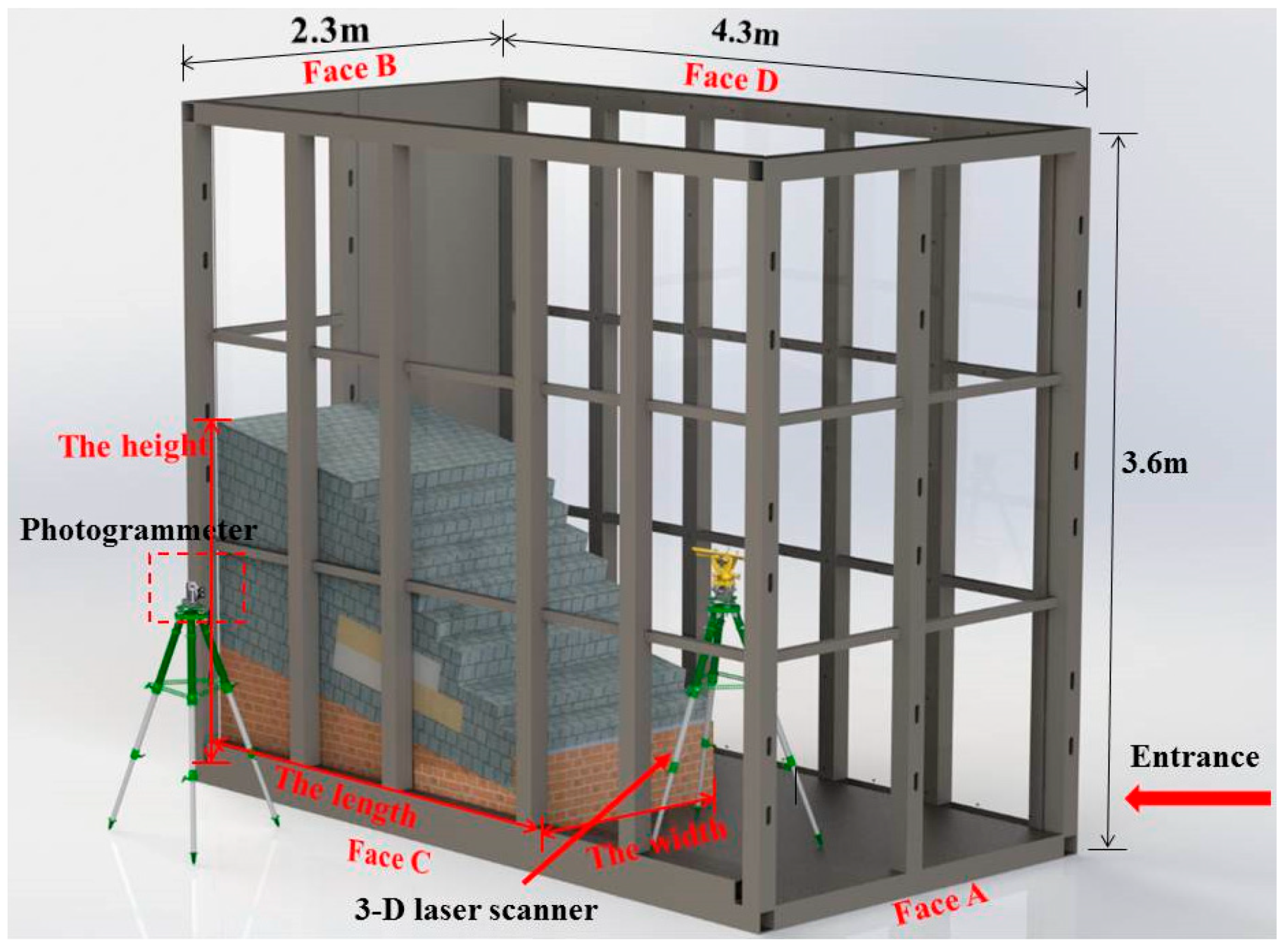
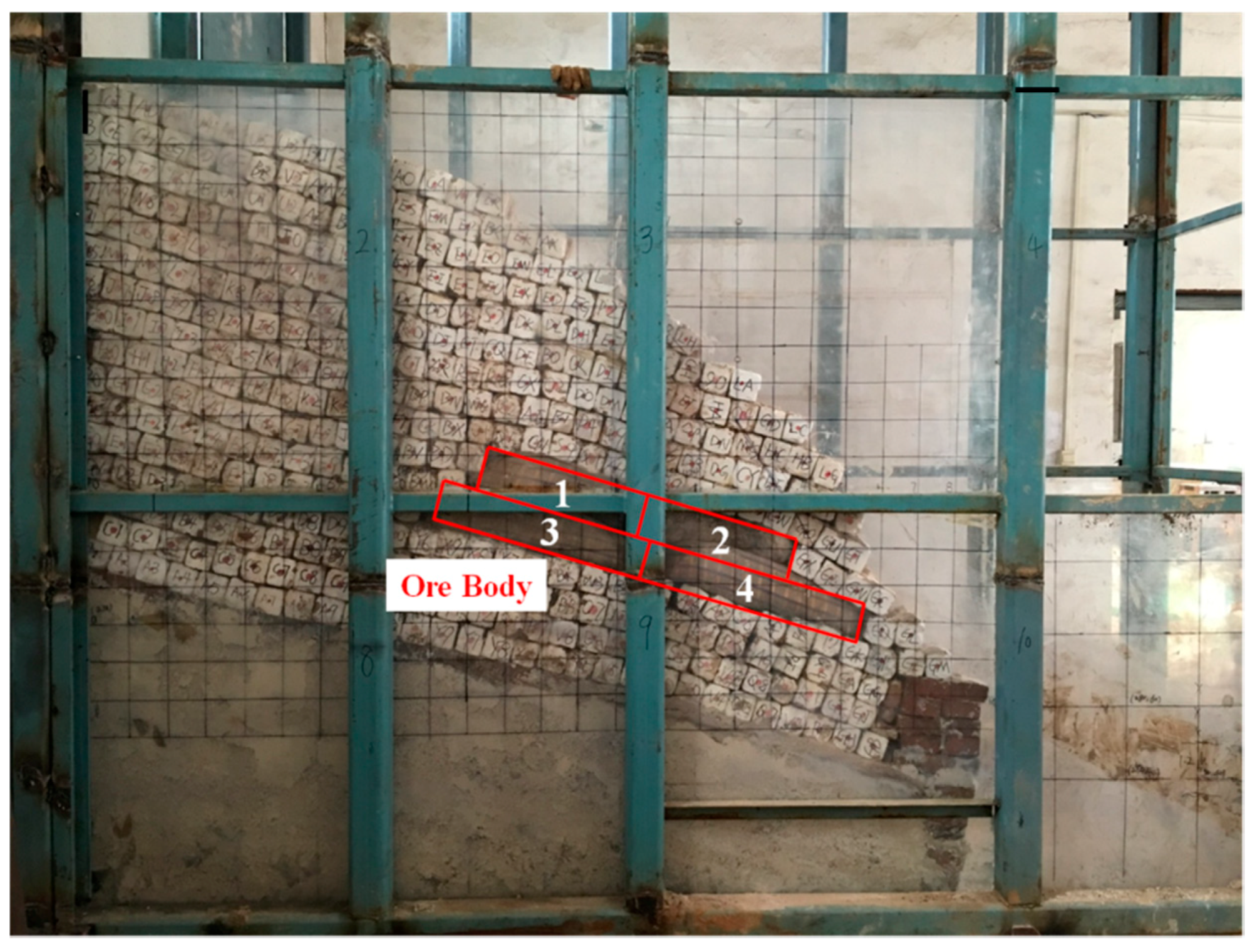
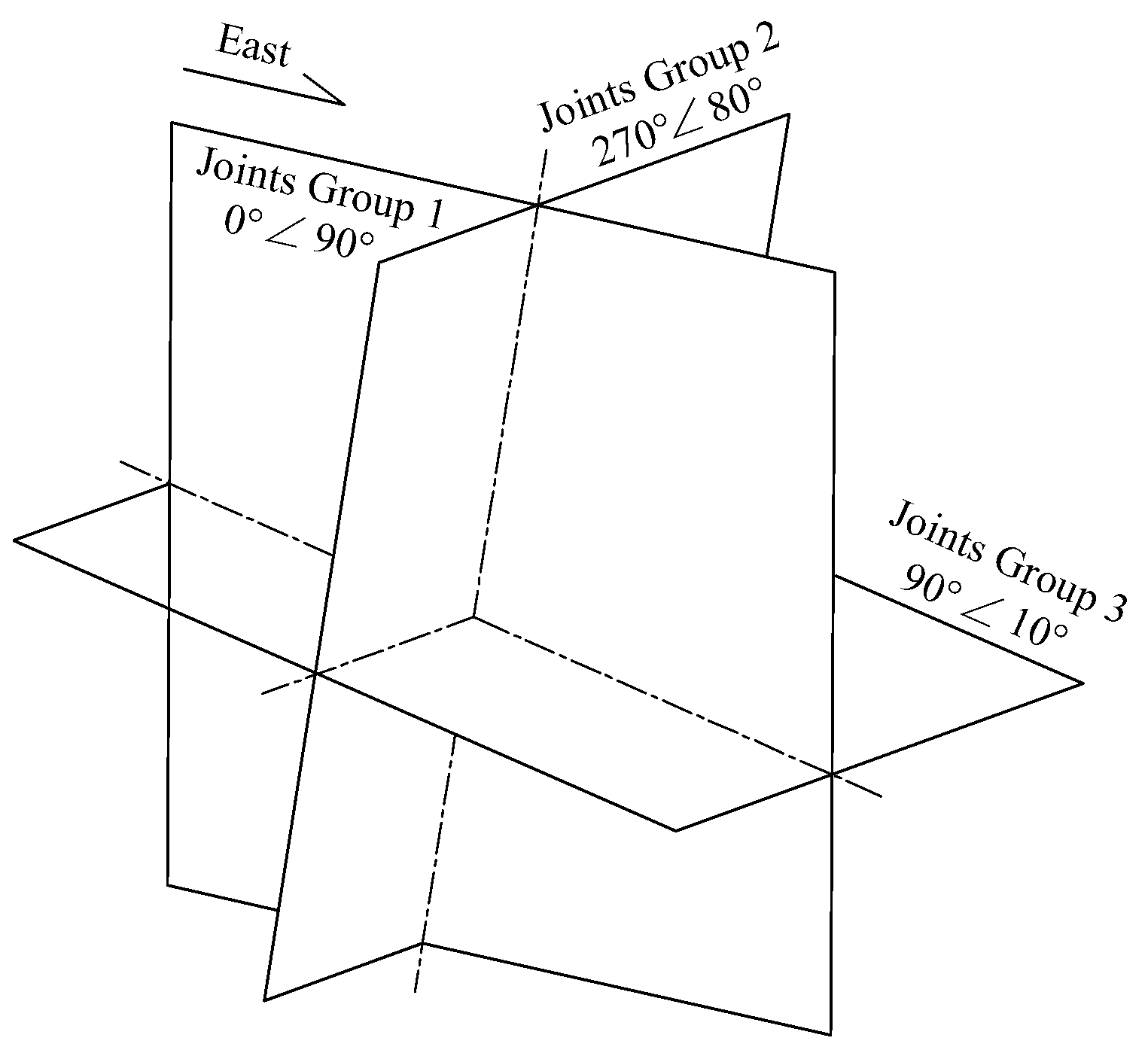
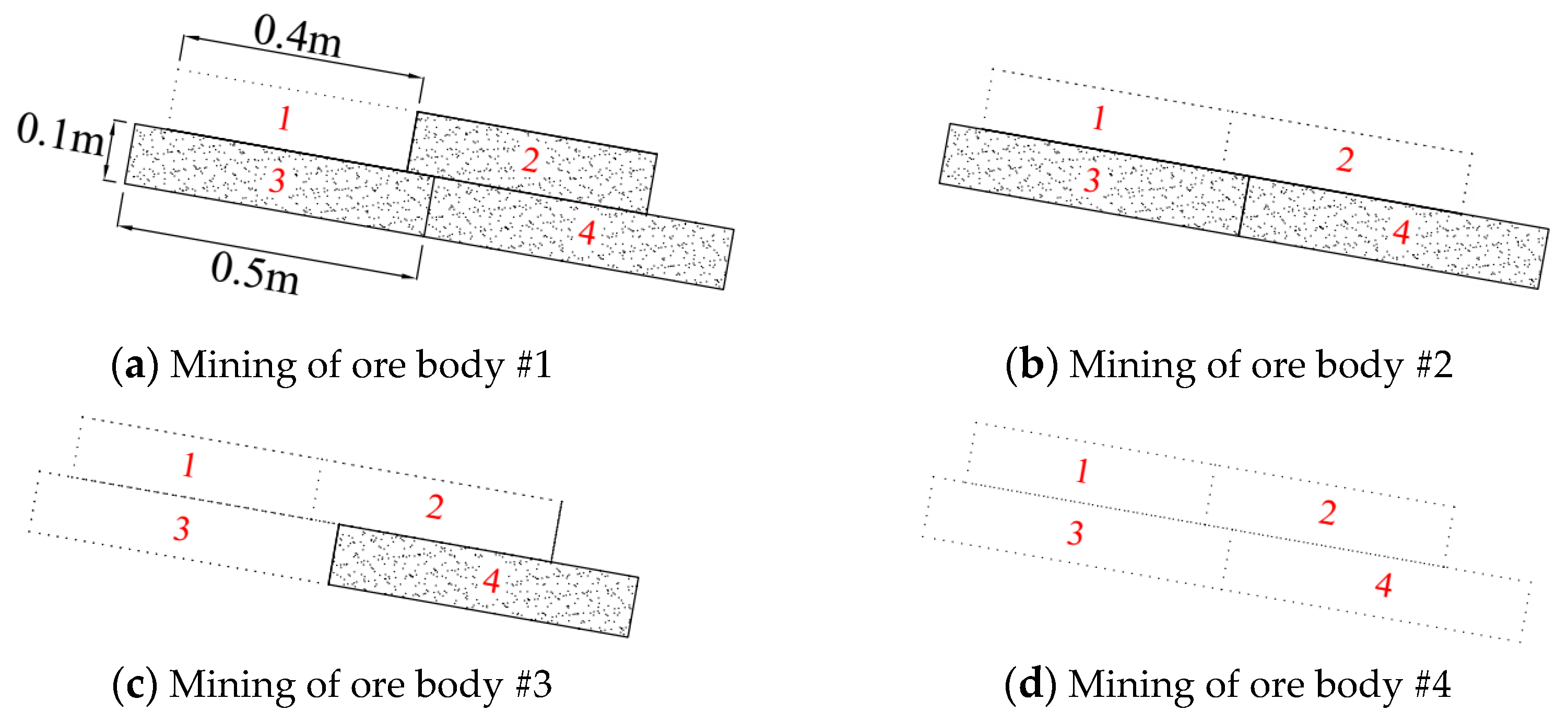

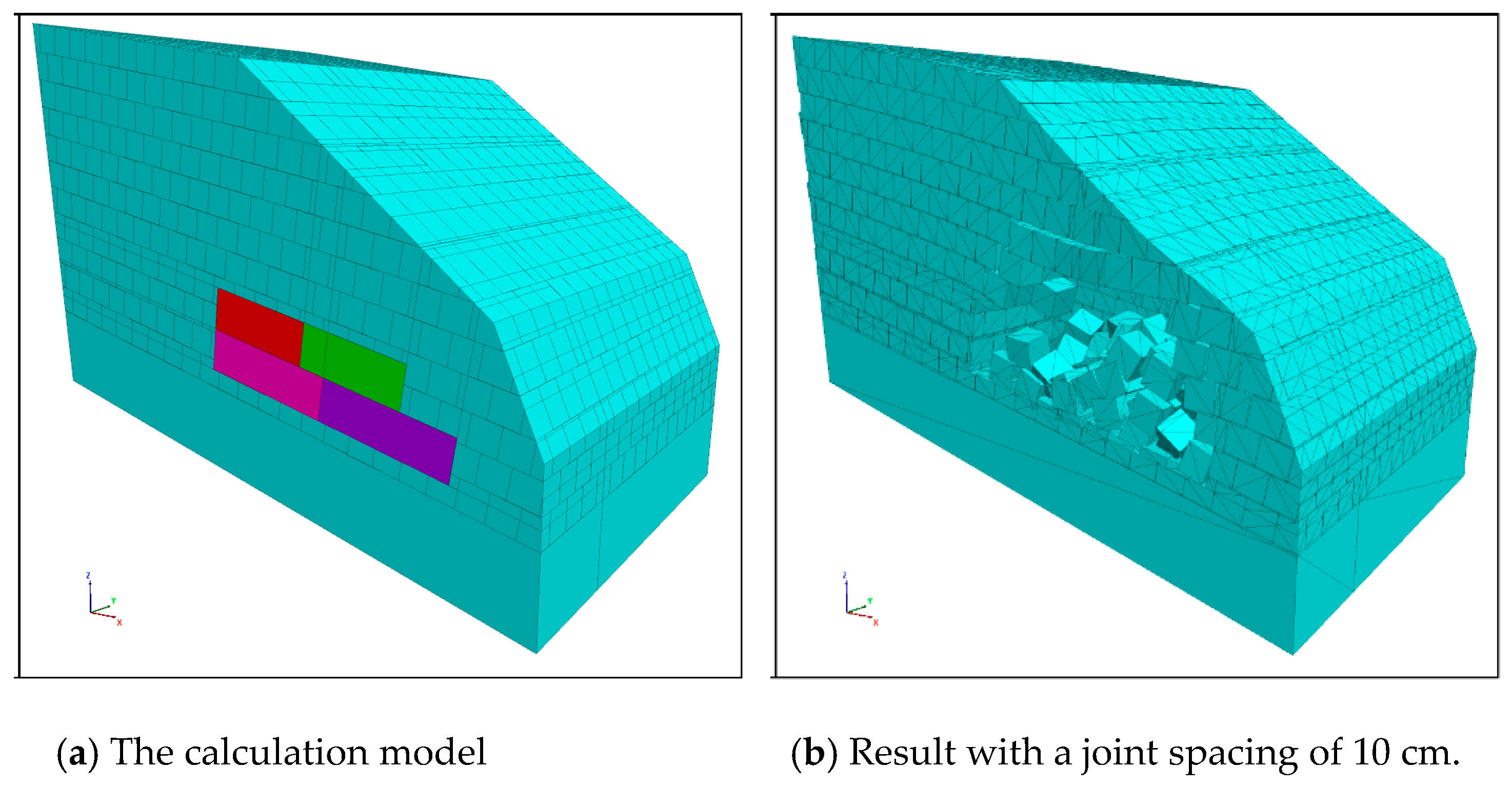



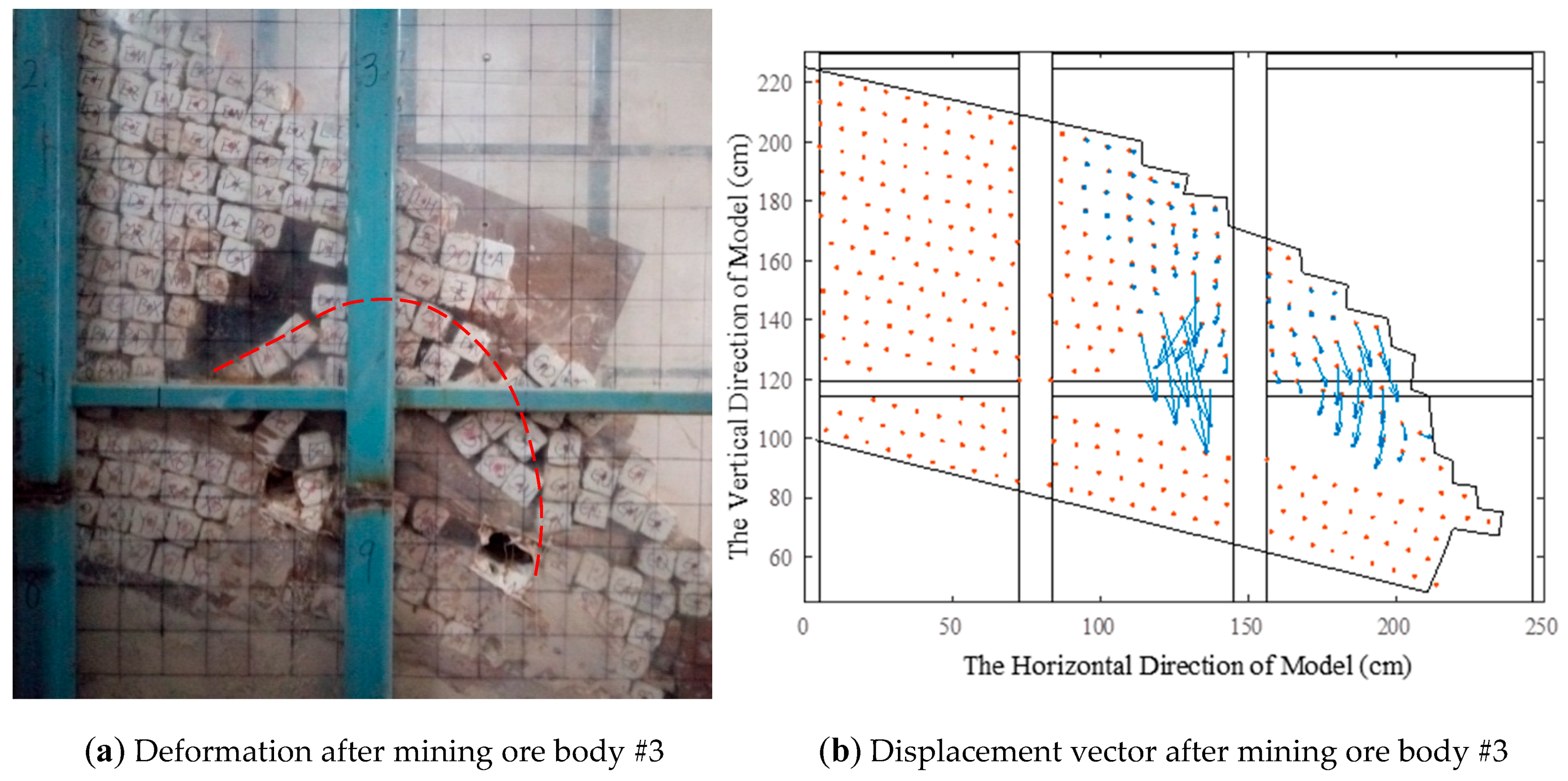
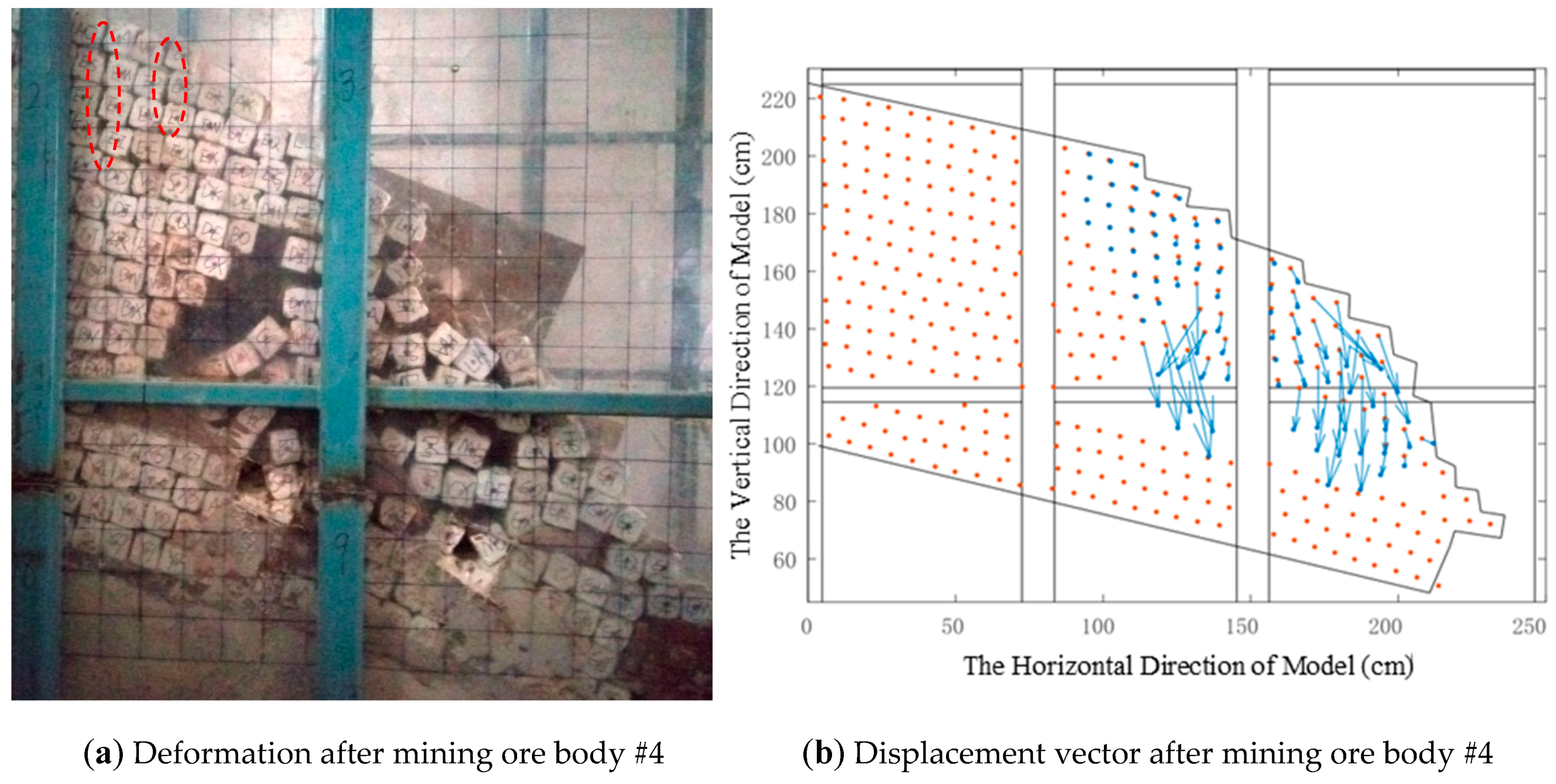
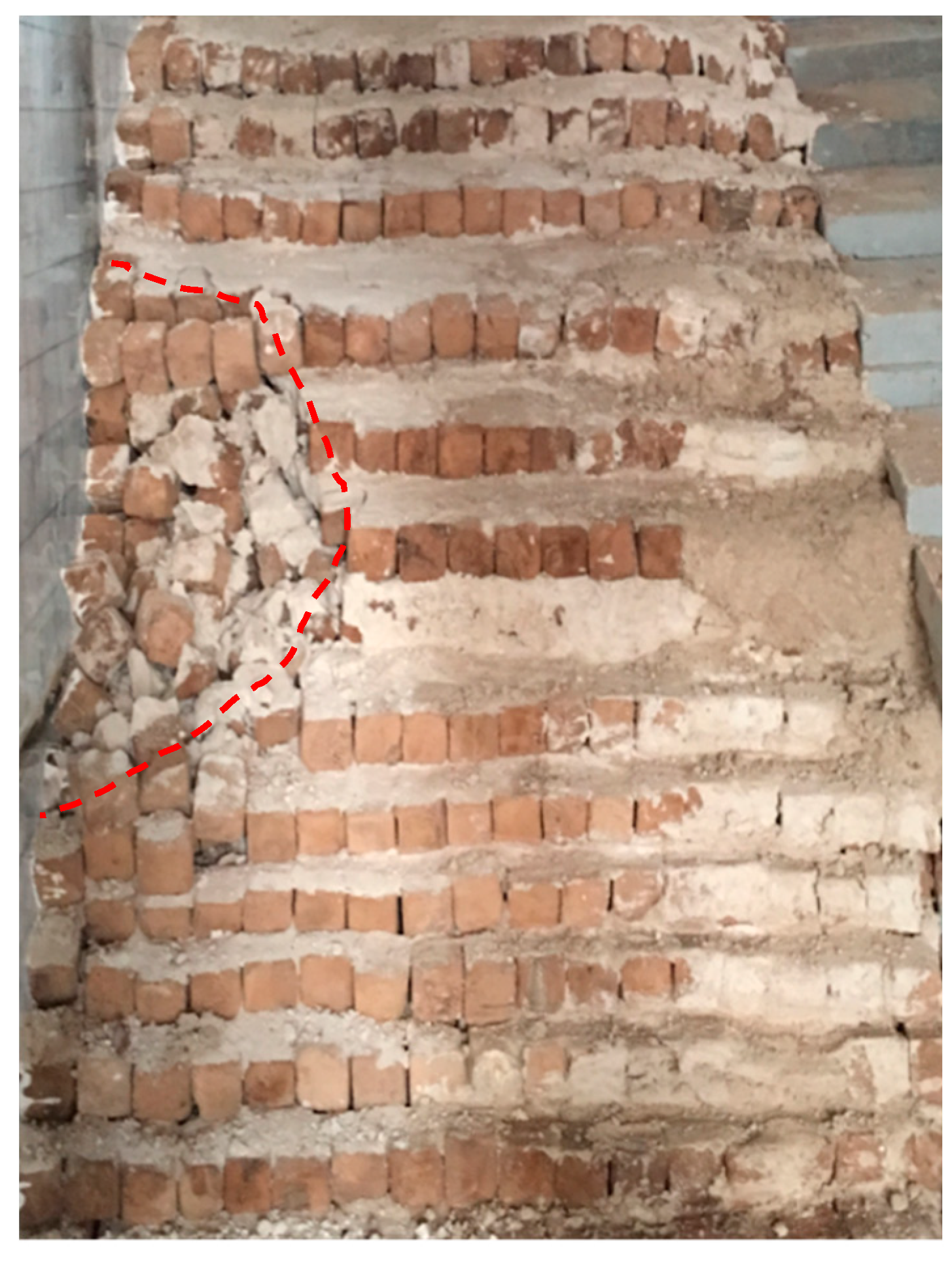

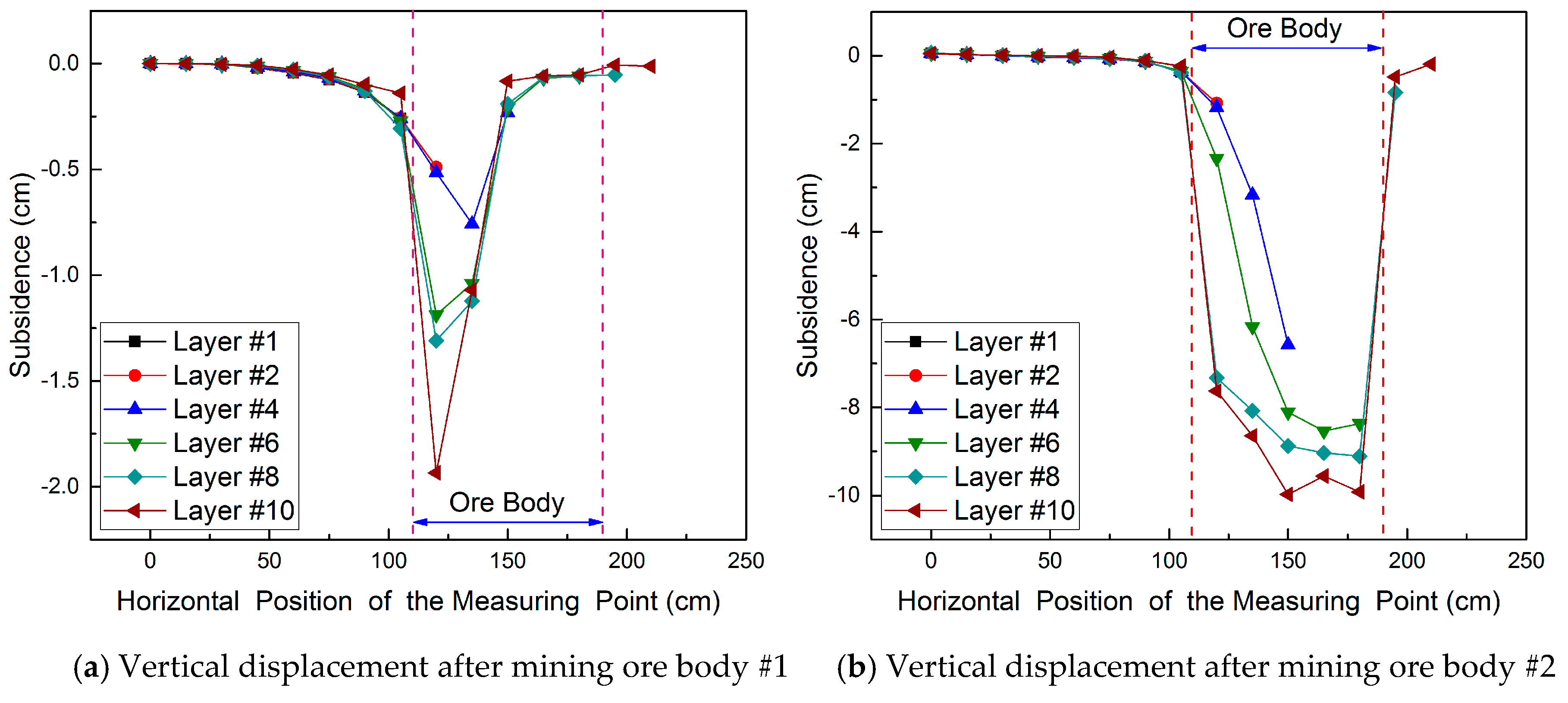
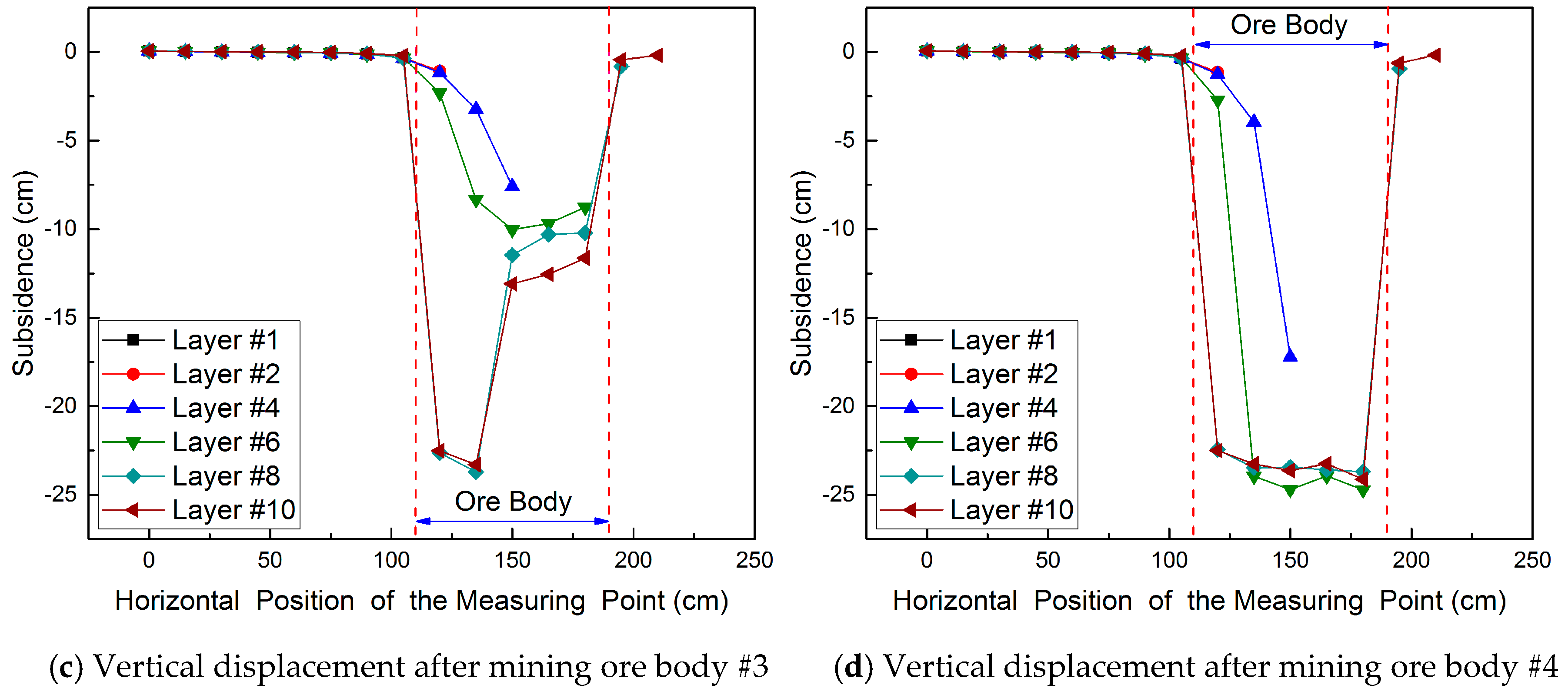
| Rock Mass | Compressive Strength (MPa) | Deformation Modulus (GPa) | Cohesion (MPa) | Internal Friction Angle (°) |
|---|---|---|---|---|
| Mixed rock | 164.34 | 3~5 | 40~50 | 38~40 |
| Diorite | 181.47 | 2 | 55~60 | 40~42 |
| Carbonaceous phyllite | 44.52 | 1.5 | 35~38 | 35~38 |
| Chlorite quartz schist | 98.56 | 1.5~2 | 40~45 | 38~40 |
| Parameters | Similarity Relationship | Similarity Ratio |
|---|---|---|
| Geometry () | —— | 200 |
| Bulk Density () | —— | 1 |
| Stress () | —— | 1 |
| Poisson’s Ratio () | —— | 1 |
| Friction Angle () | —— | 1 |
| Strain () | 200 | |
| Elastic Modulus | 200 |
| Cement | Quartz Sand | Barite | Iron Powder | Gypsum | Water |
|---|---|---|---|---|---|
| 1 | 28 | 28 | 6.67 | 3 | 7.07 |
| Density (g/cm3) | Uniaxial Compressive Strength (MPa) | Deformation Modulus (MPa) | Cohesion (MPa) | Friction Angle (°) |
|---|---|---|---|---|
| 2.56 | 0.80 | 200.61 | 0.1735 | 38.94 |
| Barite | Quartz Sand | Gypsum | White Latex |
|---|---|---|---|
| 3.5 | 4.8 | 0.9 | 1 |
| Cohesion (MPa) | Friction Angle (°) | Tensile Strength (MPa) | |
|---|---|---|---|
| Joint strength of model slope | 0.164 | 20.45 | 0.00698 |
| Joint strength of field rock | 33 | 21 | 1.5 |
© 2019 by the authors. Licensee MDPI, Basel, Switzerland. This article is an open access article distributed under the terms and conditions of the Creative Commons Attribution (CC BY) license (http://creativecommons.org/licenses/by/4.0/).
Share and Cite
Yang, G.; Leung, A.K.; Xu, N.; Zhang, K.; Gao, K. Three-Dimensional Physical and Numerical Modelling of Fracturing and Deformation Behaviour of Mining-Induced Rock Slopes. Appl. Sci. 2019, 9, 1360. https://doi.org/10.3390/app9071360
Yang G, Leung AK, Xu N, Zhang K, Gao K. Three-Dimensional Physical and Numerical Modelling of Fracturing and Deformation Behaviour of Mining-Induced Rock Slopes. Applied Sciences. 2019; 9(7):1360. https://doi.org/10.3390/app9071360
Chicago/Turabian StyleYang, Guoxiang, Anthony K. Leung, Nengxiong Xu, Kunxiang Zhang, and Kunpeng Gao. 2019. "Three-Dimensional Physical and Numerical Modelling of Fracturing and Deformation Behaviour of Mining-Induced Rock Slopes" Applied Sciences 9, no. 7: 1360. https://doi.org/10.3390/app9071360




